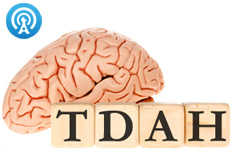Trastorno de déficit de atención e hiperactividad en adultos

1. DSM-5 development. Arlington, VA: American Psychiatric Association, 2012 (http://www.dsm5.org).
2. Wender PH. Attention-deficit hyperactivity disorder in adults. Psychiatr Clin North Am 1998;21:761-74.
3. Spencer T, Biederman J, Wilens TE, Faraone SV. Adults with attention-deficit/hyperactivity disorder: a controversial diagnosis. J Clin Psychiatry 1998;59:Suppl 7:59-68.
4. Hechtman L. Predictors of long-term outcome in children with attention-deficit/ hyperactivity disorder. Pediatr Clin North
Am 1999;46:1039-52.
5. Hinshaw SP, Owens EB, Zalecki C, et al. Prospective follow-up of girls with attention-deficit/hyperactivity disorder into
early adulthood: continuing impairment includes elevated risk for suicide attempts and self-injury. J Consult Clin Psychol2012;80:1041-51.
6. Klein RG, Mannuzza S, Olazagasti MA, et al. Clinical and functional outcome of childhood attention-deficit/hyperactivity disorder 33 years later. Arch Gen Psychiatry 2012;69:1295-303.
7. Barkley RA, Fischer M, Smallish L, Fletcher K. The persistence of attentiondeficit/ hyperactivity disorder into young adulthood as a function of reporting source and definition of disorder. J Abnorm Psychol 2002;111:279-89.
8. Faraone SV, Biederman J, Mick E. The age-dependent decline of attention deficit hyperactivity disorder: a meta-analysis of follow-up studies. Psychol Med 2006;36:159-65.
9. Barkley R, Murphy K, Fischer M. ADHD in adults: what the science says. New York: Guilford Press, 2008.
10. Weiss G, Hechtman L. Hyperactive children grown up: ADHD in children, adolescents, and adults. New York: Guilford Press, 1993.
11. Kessler RC, Adler L, Barkley R, et al. The prevalence and correlates of adult ADHD in the United States: results from the National Comorbidity Survey Replication. Am J Psychiatry 2006;163:716-23.
12. Biederman J, Fried R, Petty CR, et al. Cognitive development in adults with attention- deficit/hyperactivity disorder: a controlled study in medication-naive adults across the adult life cycle. J Clin Psychiatry 2011;72:11-6.
13. Kuntsi J, Neale BM, Chen W, Faraone SV, Asherson P. The IMAGE project: methodological issues for the molecular
genetic analysis of ADHD. Behav Brain Funct 2006;2:27.
14. Neale BM, Medland SE, Ripke S, et al. Meta-analysis of genome-wide association studies of attention-deficit/hyperactivity disorder. J Am Acad Child Adolesc Psychiatry 2010;49:884-97.
15. Zuk O, Hechter E, Sunyaev SR, Lander ES. The mystery of missing heritability: genetic interactions create phantom heritability. Proc Natl Acad Sci U S A 2012;109:1193-8.
16. Froehlich TE, Lanphear BP, Auinger P, et al. Association of tobacco and lead exposures with attention-deficit/hyperactivity disorder. Pediatrics 2009;124(6):e1054-e1063.
17. Campbell BC, Eisenberg D. Obesity, attention deficit-hyperactivity disorder and the dopaminergic reward system. Coll Antropol 2007;31:33-8.
18. Buss C, Entringer S, Davis EP, et al. Impaired executive function mediates the association between maternal pre-pregnancy body mass index and child ADHD symptoms. PLoS One 2012;7(6):e37758.
19. Rodriguez A, Miettunen J, Henriksen TB, et al. Maternal adiposity prior to pregnancy is associated with ADHD symptoms
in offspring: evidence from three prospective pregnancy cohorts. Int J Obes (Lond) 2008;32:550-7.
20. Cortese S, Kelly C, Chabernaud C, et al. Toward systems neuroscience of ADHD: a meta-analysis of 55 fMRI studies. Am J Psychiatry 2012;169:1038-55.
21. Volkow ND, Wang GJ, Kollins SH, et al. Evaluating dopamine reward pathway in ADHD: clinical implications. JAMA 2009; 302:1084-9 [Erratum, JAMA 2009;302:1420.]
22. Sonuga-Barke EJ. The dual pathway model of AD/HD: an elaboration of neurodevelopmental characteristics. Neurosci Biobehav Rev 2003;27:593-604.
23. Arnsten AF, Rubia K. Neurobiological circuits regulating attention, cognitive control, motivation, and emotion: disruptions in neurodevelopmental psychiatric disorders. J Am Acad Child Adolesc Psychiatry 2012;51:356-67.
24. Sibley MH, Pelham WE Jr, Molina BS, et al. Diagnosing ADHD in adolescence. J Consult Clin Psychol 2012;80:139-50.
25. McGough JJ, Smalley SL, McCracken JT, et al. Psychiatric comorbidity in adult attention deficit hyperactivity disorder: findings from multiplex families. Am J Psychiatry 2005;162:1621-7.
26. Kolar D, Keller A, Golfinopoulos M, Cumyn L, Syer C, Hechtman L. Treatment of adults with attention-deficit/hyperactivity disorder. Neuropsychiatr Dis Treat 2008;4:107-21.
27. Teter CJ, McCabe SE, LaGrange K, Cranford JA, Boyd CJ. Illicit use of specific prescription stimulants among college students: prevalence, motives, and routes of administration. Pharmacotherapy 2006; 26:1501-10.
28. Wilens TE, Morrison NR, Prince J. An update on the pharmacotherapy of attention- deficit/hyperactivity disorder in adults. Expert Rev Neurother 2011;11:1443-65.
29. Shaw M, Hodgkins P, Caci H, et al. A systematic review and analysis of longterm outcomes in attention deficit hyperactivity disorder: effects of treatment and non-treatment. BMC Med 2012;10:99.
30. Lensing MB, Zeiner P, Sandvik L, Opjordsmoen S. Four-year outcome in psychopharmacologically treated adults with
attention-deficit/hyperactivity disorder: a questionnaire survey. J Clin Psychiatry 2013;74(1):e87-e93.
31. Lichtenstein P, Halldner L, Zetterqvist J, et al. Medication for attention deficit– hyperactivity disorder and criminality. N Engl J Med 2012;367:2006-14.
32. Fredriksen M, Halm.y A, Faraone SV, Haavik J. Long-term efficacy and safety of treatment with stimulants and atomoxetine in adult ADHD: a review of controlled and naturalistic studies. Eur Neuropsychopharmacol 2013;23:508-27.
33. Swanson JM, Volkow ND. Psychopharmacology: concepts and opinions about the use of stimulant medications. J Child Psychol Psychiatry 2009;50:180-93.
34. Moriyama TS, Polanczyk GV, Terzi FS, Faria KM, Rohde LA. Psychopharmacology and psychotherapy for the treatment of adults with ADHD — a systematic review of available meta-analyses. CNS Spectr 2013 June 6 (Epub ahead of print).
35. Habel LA, Cooper WO, Sox CM, et al. ADHD medications and risk of serious cardiovascular events in young and middle- aged adults. JAMA 2011;306:2673-83.
36. Mick E, McManus DD, Goldberg RJ. Meta-analysis of increased heart rate and blood pressure associated with CNS stimulant treatment of ADHD in adults. Eur Neuropsychopharmacol 2013;23:534-41.
37. FDA drug safety communication: safety review update of medications used to treat attention-deficit/hyperactivity disorder (ADHD) in children and young adults. November 1, 2011 (http://www.fda.gov/ drugs/drugsafety/ucm277770.htm).
38. Volkow ND, Swanson JM. Variables that affect the clinical use and abuse of methylphenidate in the treatment of ADHD. Am J Psychiatry 2003;160:1909-18.
39. Smith ME, Farah MJ. Are prescription stimulants “smart pills”? The epidemiology and cognitive neuroscience of prescription stimulant use by normal healthy individuals. Psychol Bull 2011;137:717-41.
40. Christman AK, Fermo JD, Markowitz JS. Atomoxetine, a novel treatment for attention-deficit-hyperactivity disorder. Pharmacotherapy 2004;24:1020-36.
41. Faraone SV, Glatt SJ. A comparison of the efficacy of medications for adult attention- deficit/hyperactivity disorder using meta-analysis of effect sizes. J Clin Psychiatry 2010;71:754-63.
42. Modafinil (CEP- 1538) tablets: supplemental NDA 20-717/S-019 ADHD indication — briefing document for Psychopharmacologic Drugs Advisory Committee Meeting. Frazer, PA: Cephalon, 2006 (http://www .fda.gov/ohrms/dockets/ac/06/briefing/2006 -4212b1-01-cephalon-background.pdf ).
43. Young S, Amarasinghe JM. Practitioner review: non-pharmacological treatments for ADHD: a lifespan approach. J Child Psychol Psychiatry 2010;51:116-33.
44. Seixas M, Weiss M, Müller U. Systematic review of national and international guidelines on attention-deficit hyperactivity disorder. J Psychopharmacol 2012;26:753-65.
45. Mongia M, Hechtman L. Cognitive behavior therapy for adults with attentiondeficit/ hyperactivity disorder: a review of recent randomized controlled trials. Curr Psychiatry Rep 2012;14:561-7.
46. Goodman DW. Sustained treatment effect in attention-deficit/hyperactivity disorder: focus on long-term placebocontrolled randomized maintenance withdrawal and open-label studies. Ther Clin Risk Manag 2013;9:121-30.
47. Volkow ND, Wang GJ, Newcorn JH, et al. Motivation deficit in ADHD is associated with dysfunction of the dopamine
reward pathway. Mol Psychiatry 2011;16:1147-54.
48. Torrente F, Lischinsky A, Torralva T, López P, Roca M, Manes F. Not always hyperactive? Elevated apathy scores in adolescents and adults with ADHD. J Atten Disord 2011;15:545-56.
49. Conzelmann A, Mucha RF, Jacob CP, et al. Abnormal affective responsiveness in attention-deficit/hyperactivity disorder: subtype differences. Biol Psychiatry 2009; 65:578-85.
50. National Institute for Health and Clinical Excellence. Attention deficit hyperactivity disorder: the NICE guideline on diagnosis and management of ADHD in children, young people and adults. London: British Psychological Society and Royal College of Psychiatrists, 2009 (http://www.nice.org.uk/nicemedia/pdf/adhdfullguideline.pdf).
51. Kooij SJ, Bejerot S, Blackwell A, et al. European consensus statement on diagnosis and treatment of adult ADHD: the European Network Adult ADHD. BMC Psychiatry 2010;10:67.
Comentarios
Para ver los comentarios de sus colegas o para expresar su opinión debe ingresar con su cuenta de IntraMed.









